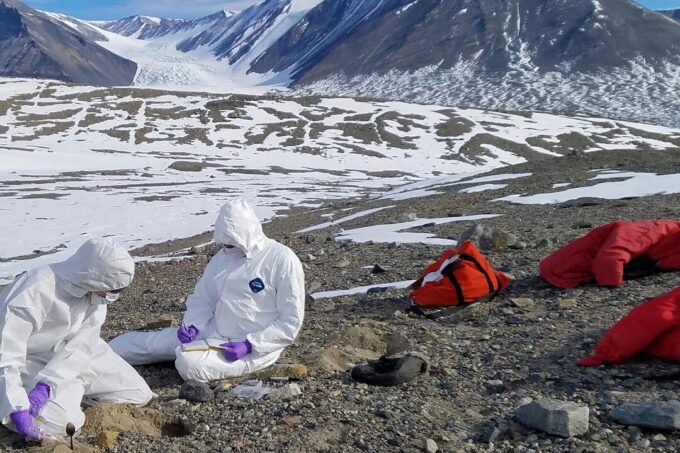Watch and read the transcript on Slice of MIT
Can you imagine a color you’ve never seen? That’s the type of thinking Sarah Stewart Johnson PhD ’08, professor and researcher at Georgetown University, applies to her work in planetary science. She and her team are working on novel ways to detect life as we’ve never known it. What they come up with could help us discover whether entirely different forms of life once existed on Mars.
“Right now, we just have one data point for life—it’s the life that we have here on Earth,” explains Johnson, “the carbon-based, DNA-based life that we have here on our own planet.” Her research lab has spent a lot of time uncovering traces of that life in some of the most remote and extreme environments around the globe—polar deserts, volcanic terrains—places that are thought to resemble the surface of Mars. Now, with a $7M grant from NASA, she and her colleagues are pioneering new tools and technologies that could be used to fingerprint life based on a different molecular framework.
On February 18, NASA’s Mars 2020 Perseverance rover completed its journey to the Red Planet with the goal of bringing back samples, something that Johnson says will be transformational in terms of our understanding of that world. Scientists, including several at MIT, are eagerly awaiting the chance to study what the mission carries home, hopefully sometime in the next decade. Johnson’s team hopes they will be among those with access to those samples, opening a new dimension to the research they’ve begun on Earth.
Johnson was first exposed to space exploration by her father, an amateur astronomer and geologist, and the interest took root in her first year of college at Washington University in Saint Louis. “Mars is my first love,” says Johnson, who was thrilled to begin planetary research after meeting a professor who had worked on the Mars Pathfinder mission in 1997. “The world felt like it was completely opening up. I grew up in Kentucky and seldom crossed the state line, and then suddenly it felt like the universe was at my doorstep to be studied.”
A Rhodes Scholarship at Oxford studying philosophy prepared Johnson for the big questions she faced as a PhD student in planetary science at MIT studying under her mentor Maria Zuber, the E. A. Griswold Professor of Geophysics and current vice president for research, who she describes as inspiring and brilliant.
Johnson worked on NASA’s Spirit and Opportunity rovers, completed a postdoctoral fellowship, and was selected as a White House Fellow in the Obama Administration. After she was hired as a professor at Georgetown in 2014, she began collaborative research with the Planetary Environments Lab at NASA’s Goddard Space Flight Center and joined the Curiosity rover team. Drawing on her work thus far and the history of her field, she wrote The Sirens of Mars: Searching for Life on Another World, which was named one of the 100 notable books of 2020 by the New York Times. The process helped to make her a better scientist, she says, giving her the opportunity to reflect on the nature of exploration and leading her to a new way of thinking about her work.
One result of that thinking is her lab’s recent focus on agnostic biosignatures: traces of life that don’t necessarily share Earth’s specific biochemistry. “As we move away from Earth, I think it’s critical to consider forms of life that we are only beginning to imagine,” she says.
Story Image: Scientists look for live and biosignatures in Dry Valleys, Antarctica. (Credit: courtesy of Sarah Stewart Johnson/Slice of MIT)



